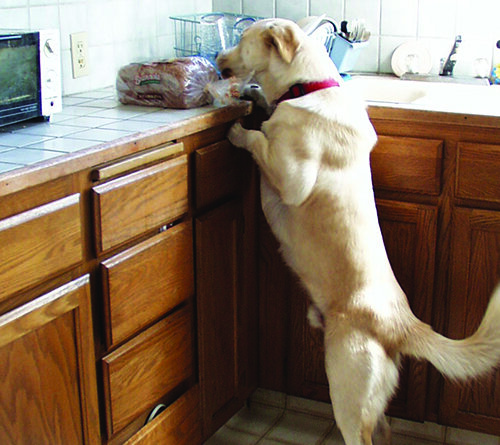Counter Productive: How to Keep Your Dog From Stealing Unattended Food and Other Edible Items

One of the hardest canine behaviors for some dog owners to understand (or forgive) is counter-surfing – when your dog helps himself to some edible item that you or another household human left unattended. The behavior isn’t just limited to counters; some dogs help themselves to any food left on tables, desks, coffee tables, or any other unguarded surface. Some dogs specialize in finding any food you have hidden in your car!
COUNTER SURVEILLANCE
Smart dog owners understand that canids are naturally “opportunistic eaters” – they are genetically programmed to eat food when they see or find it. Of course, that doesn’t mean we should just let them help themselves to anything in the house that they can find! Dogs are genetically programmed to do a lot of things we don’t just let them do.
However, it does mean that we have to scrupulously manage our dog’s environment, in hopes that they never learn the joy of counter-surfing in the first place, but also so that if they already have, we can reprogram the learning (i.e., modify the behavior).
Management is pretty simple. It just means never leaving unattended food anywhere your dog can get it. Alternatively, you can restrain or put your dog away (closed in another room, behind a baby gate, tethered, or crated) if you must leave food out.
If you do this starting from puppyhood, so your dog never gets an opportunity to abscond with the deli tray or butter dish on the counter, there’s a good chance he won’t decide to leap onto counters when he reaches adulthood.
Still, it’s not a good idea to take good behavior for granted, or frequently present your dog with unnecessarily hard-to-ignore temptations.
Our two dogs have never counter-surfed; they are both small (under 35 pounds) and have reasonably good house manners, so we trust that our food is safe on the kitchen counter or dining room table (even though they are both quite capable of jumping that high, if they wanted to). I wouldn’t dream, however, of leaving food on our coffee table and walking out of the room; there’s no point in tempting fate!
If you choose to manage your dog, rather than keeping the counters reliably free of food, make good use of our usual list of management tools to prevent your dog from having access to food on counters and tables: Doors, baby gates, crates, exercise pens, leashes, tethers, and (last but least, as it has the best chance of failure due to human error) direct supervision.
Not Guilty
Some dogs seem incorrigible about helping themselves to any food they can find in the house – and some humans get hopping mad about it. “I’ve punished him many times for this,” they say. “He knows he’s not supposed to do it. He only does it when I’m not in the room, and he always looks guilty afterward. So clearly he knows better!”
The thing is, he really doesn’t know better. What he does know is that bad things happen (you get angry, or perhaps even a little violent) if he takes food off the counter when you are there. However, nothing bad happens if he takes yummy stuff off the counter when you aren’t there, so it’s okay – and safe – to do it then.
Generally, by the time you discover his latest transgression and punish him for it (we don’t recommend this), the punishment is too far removed from his action; he won’t associate the punishment with his taking the food. All he really knows is that sometimes you are grumpy when you enter the kitchen (or wherever the food had been).
So what about those guilty looks? If your dog doesn’t know he did a bad thing, why does he look guilty?
In 2009, dog cognition scientist Alexandra Horowitz, Ph.D., author of Inside of a Dog: What Dogs See, Smell, and Know (Scribner, 2009) and Being a Dog: Following the Dog Into a World of Smell (Scribner, 2016), tried to answer that question with a study, “Disambiguating the ‘Guilty Look.’”
Horowitz set up a situation where the owner would put a treat where their dog could reach it, tell the dog to leave it alone, and leave the room. When the owner returned, Horowitz sometimes reported to the owner that the dog had eaten the treat even if he hadn’t (the researchers removed the food from the plate). In these instances, the owners most frequently described their dogs as looking guilty, even though, unbeknownst to them, the dog had not taken the treat. Additionally, if the owners scolded the dogs, the dogs frequently looked “guilty” – whether they had eaten the treat or not. In fact, Horowitz also found that when scolded, the most exaggerated guilty looks were frequently offered by the dogs who had not eaten the treat!
The behavior and expression that owners often think is an indication of guilt – a hunched, lowered posture, ears back, eyes averted, sometimes accompanied by a submissive grin – is actually appeasement behavior; it indicates that the dog is fearful. It means he has read your body language, understands that you are upset, and is trying to appease you so you don’t take it out on him.
If your dog’s counter-surfing and your anger about it is separated in time by more than several seconds, he has no idea why you are angry, but he doesn’t want your wrath descending on him. Even if you aren’t overtly angry, he can tell when you are upset about something, so he offers body language intended to deflect your emotions.
Note: While the dog’s behavior in the counter-surfing scenarios described here are not an indication of guilt, that does not mean dogs cannot feel guilt. We don’t know that yet. It’s possible that they can. But this isn’t it.
COUNTER INTELLIGENCE: MODIFICATION
My own unproven and untested theory, based on anecdotal evidence alone, is that the truly dedicated counter-surfers tend to be smart, confident dogs with resilient personalities. Some are truly masters of the art of taking food – practically from under your very nose, without you ever noticing. You have to admire ninja skills like that! You might even be in the kitchen with your dog and you think you’re doing a good job of managing, but you turn your back for a second and oops! The holiday ham has been swiped from the counter.
There is certainly value in modifying counter-surfing behavior, especially if you have one of those expert surfers, or if management won’t be consistent in your household; perhaps you care for an elderly parent with dementia, or have distracted, spontaneous children roaming your home. When scrupulous management isn’t possible, by all means, use behavior modification!
Here are some useful training tools you can teach your counter-surfing canine:
* Mat training. Teach your dog that her place in the kitchen is on her mat, conveniently placed in the corner. Cue her to go to her mat as needed, and then watch for her to start going to her mat on her own, without a cue. When this happens, be sure to reinforce her happily and generously! (For more detail about teaching this behavior, see “Useful Matters,” WDJ January 2020.)
Work to increase the duration of time that you want her to stay on the mat, until she will stay there happily for long periods, with long pauses between reinforcers. Continue to reinforce her on her mat in the kitchen (or wherever food is present) to keep the behavior strong.
* Leave It. A well-trained, well-timed, cheerful “Leave it!” cue can work wonders, especially if it’s delivered right at the moment when you see your dog eyeing the turkey sandwich that one of the kids left on the coffee table.
I teach that “Leave it” means “forever,” so if you do have to leave the kitchen for a brief moment, your “Leave it” cue can help ensure the safety of any unattended food – but don’t count on it for more than a few seconds!
Start by saying “Leave it!” and putting a treat under your foot, then waiting for your dog to stop trying to get it out from under your shoe. The instant she stops, “mark” the moment with a signal, such as the click of a clicker or the word “Yes!” and give her a treat. Continue using the marker (click or “Yes!”) and giving her a treat every few seconds, in random durations (but not too long), as long as she doesn’t go back to the shoe. If she does try to get the treat again, just wait until she stops, then mark/treat again.
It’s a fun behavior to teach! You are setting up your dog to make the right choice, then reinforcing her when she does. It’s one of those rewarding-for-the-human positive-training moments where you get to see the light bulb come on, when your dog looks at the treat and then deliberately looks away. (For more instruction on teaching this behavior, see “Leaving for Good,” June 2018.)
*Walk Away. The “Leave it” cue tells your dog not to eat whatever she is coveting; in contrast, the “Walk Away” moves her promptly away from the food that she’s eyeing on the counter or table. In many cases, this is more effective, because it tells your dog what to do (and reinforces her for doing it) instead of just telling her what not to do.
Being able to teach your dog to move away from something when asked is an invaluable tool, both for your dog’s safety and for your sanity. It has become one of my favorite behaviors to teach and use.
We start teaching this behavior by tossing treats for our dog to chase and eat. When he thoroughly understands the “game” of watching to see where you toss the treats so he can pursue and eat them, you present him with a novel but neutral (uninteresting) item that may draw his attention for a moment. When he moves toward the item to investigate it with a sniff, you cue “Walk Away!” and run away, tossing treats behind him, so he whips a U-turn and pursues the treats.
There are more steps and more practice required for a reliable “Walk Away!” behavior, but you get the idea. For detailed instructions on teaching this behavior to your dog, see “Walk Away!” in the September 2018 issue.
BEWARE THE GREMLIN: INTERMITTENT REINFORCEMENT

In behavior science terms, you “extinguish” your dog’s counter-surfing behavior by not leaving any food on the counter for him to find – ever – thus removing all possible reinforcement. Behaviors that aren’t reinforced in some way eventually go away. But if your dog happens to score a sandwich or a savory pie while you are trying to extinguish the food-seeking behavior – even just once! – the behavior will be so strongly reinforced that it will be difficult to extinguish again.
So, if you really want to extinguish your dog’s counter-surfing behavior, your management has to be flawless. If your dog has access to a goodie on the counter every now and then, she will continue to search for random prizes that she can snatch when no one is looking. And each time she does, she’ll become even more convinced that the counter will eventually pay off. The behavior will become even more durable, and she will keep scouting the surface of the counter even longer.
Think about this: Let’s say you’re walking to work and you happen to glance at some pretty marigolds in a street-side planter. To your surprise and delight, you find a $100 bill tucked under the leaves of the plant. Want to bet you’ll check the planter again the next day? And the next?
If, four days later, you happen to find another $100 bill, you’re for sure going to keep checking the planter every time you go by, for a long time. Finding another bill in 20 or 30 days will only convince you to keep looking, even if there are very long gaps between finding one $100 bill and the next. In fact, you’d probably keep looking even if you “just” found a $20 bill!
COUNTER CLAIM: ALL FIXED?

You’ve invested extensive time and energy into managing and modifying your dog’s behavior. He no longer snags food off the kitchen counter when you turn your back. In fact, he’s very good about relaxing on his mat in the corner when you are in the kitchen preparing food, and you’re very good about continuing to reinforce him for that. Congrats!
Can we say he’s “fixed” now? Is it okay to let your guard down and leave food on the counter even when you’re not there?
With some dogs, perhaps; but for most, probably not.
Some dogs have very strong food-seeking behaviors. For example, as most animal-care professionals are aware (and most owners realized early in their Labrador experience), Labrador Retrievers are notorious chow-hounds. It’s actually suspected of being a genetically inherited trait! In 2016, researchers found a gene believed to be responsible for the Labrador’s well-known magnetic attraction to food.
Your counter-surfing Lab – or any other dog with strong food-accessing behaviors – is likely to need management for the rest of his life, even after an excellent modification program.
Think back to that planter with the marigolds and the occasional $100 bills. If you went months without finding any more money, you’d probably stop checking every day – but you might still take a peek under the flowers every once in a while. And if at some point you found more money – even just a $5 bill – you’d likely go back to checking that planter regularly again, right?
When we modify behavior, the old behavioral response (neuron pathway) doesn’t go away; it just gets overlaid by the new behavioral response. If something happens to trigger the old response, the behavior can (and often does) quickly pop back up (this is called a spontaneous recovery).
EVEN TRAINERS’ DOGS STRUGGLE WITH THIS
In my Cognition Academy, we sometimes conduct a “Leave It Test” with trainers and their relatively well-trained dogs. The trainers place a bowl of food on the floor and tell their dogs to “Leave it!” Often, as long as the trainer faces her dog and watches, most of the dogs are very reliable about abstaining from eating the food.
Amusingly, however, if the trainers cover their eyes, turn their backs to their dogs, or step behind a barrier, more than 90% of the dogs will help themselves to the food within 10 minutes. Most eat the food within 60 seconds or less!
If your dog has a history of getting reinforcement for counter-surfing, and you’ve put effort into modifying his behavior so he’s far less likely to help himself to available food, keep up reasonable management protocols as well. Don’t waste all that effort by tempting him into transgression – just don’t. If you do – and he fails, it’s your fault, not his.
Author Pat Miller, CBCC-KA, CPDT‑KA, is WDJ’s Training Editor. She and her husband live in Fairplay, Maryland, site of her Peaceable Paws training center. Miller is also the author of many books on dog-friendly training. See page 24 for book purchasing and contact information.





